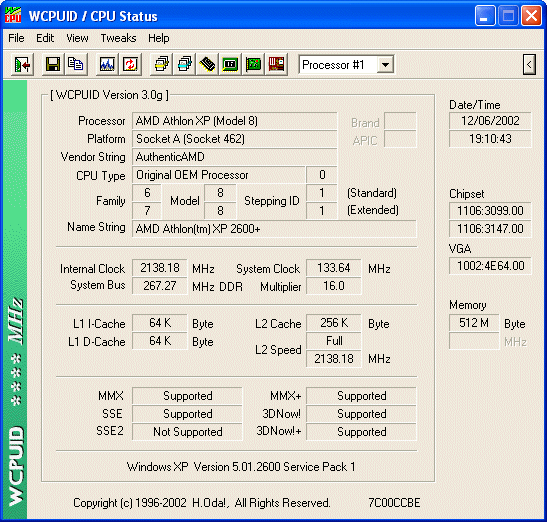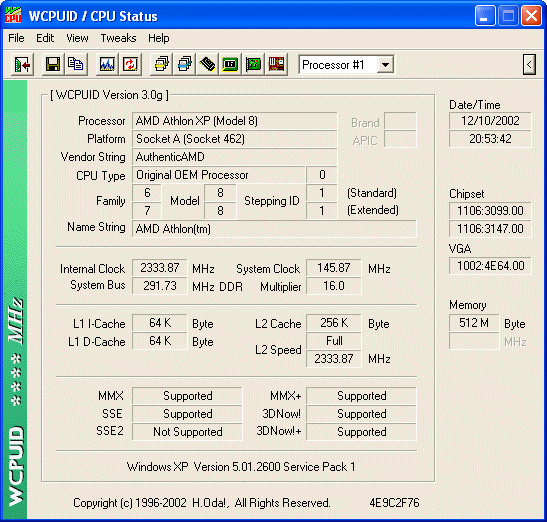| |
|
|
Date: |
December 11th,
2002 |
| Type: |
Review |
| Supplier: |
AMD |
| Author: |
mayhem |
| RRP: |
$685
AUS (inc GST) |
Introductions
With enthusiasts waiting patiently for AMD to release their 2.0 GHz+ chips
this year, the new XP 2400+ (2.0 GHz) and XP 2600+ (2.133 GHz) have made
a big impression on the market being the first of the AMD line to reach
2GHz at standard clock frequency. AMD has found new power in the Thoroughbred
core with the move to 0.13u (seen first in the XP 2200+) and look to make
good headway towards the 3.0 GHz barrier recently achieved with Intel's
Pentium 4 processors, but it hasn't been without problems.
With Intel making
great progress with their 0.13u process switch, namely with the Pentium
4 Northwood processor receiving massive percentage overclocks and a general
willingness for the CPU's to go high from day one. Intel have followed
through with this and the 0.13u Pentium 4's have scaled excellently and
we can see this as they have just reached the 3.0 GHz mark.
The initial Thoroughbred
chip, namely the XP 2200+, just didn't seem to be able to handle anything
more than the 2GHz mark with overclocking and basically seemed to have
hit a wall, this didn't look good for AMD's new line of processors. But
this is what makes the new Thoroughbred so interesting, AMD have been
able to improve their initial designs and add a few changes that allow
the chips to run faster and cooler yet using the same voltage, with only
a slightly larger core using more transistors.


So lets get stuck
into it to find out what the XP 2600+ has to offer and more importantly,
how it performs.
Features
The main advantage of the XP 2400+ and the XP 2600+ is the previously
mentioned 0.13u process used to create the chips, allowing them to run
faster and cooler than previous chips that used the 0.18u process, but
this is not the only advantage, here is some official information regarding
the new chip:
Key Architectural Features
of the AMD Athlon™ XP Processor:
- QuantiSpeed™ Architecture for enhanced
performance
- Nine-issue superpipelined, superscalar
x86 processor microarchitecture designed for high performance
- Multiple parallel x86 instruction decoders
- Three out-of-order, superscalar, fully
pipelined floating point execution units, which execute x87 (floating
point), MMX™ and 3DNow!™ instructions
- Three out-of-order, superscalar, pipelined
integer units
- Three out-of-order, superscalar, pipelined
address calculation units
- 72-entry instruction control unit
- Advanced hardware data prefetch
- Exclusive and speculative Translation
Look-aside Buffers
- Advanced dynamic branch prediction
3DNow!™ Professional
technology for leading-edge 3D operation:
- 21 original 3DNow!™ instructions—the
first technology enabling superscalar SIMD
- 19 additional instructions to enable
improved integer math calculations for speech or video encoding and
improved data movement for Internet plug-ins and other streaming applications
- 5 DSP instructions to improve soft
modem, soft ADSL, Dolby Digital surround sound, and MP3 applications
- 52 SSE instructions with SIMD integer
and floating point additions offer excellent compatibility with Intel's
SSE technology
- Compatible with Windows® XP, Windows
98, Windows 95, and Windows NT® 4.x operating systems
266MHz AMD Athlon™ XP
processor system bus enables excellent system bandwidth for data movement-intensive
applications:
- Source synchronous clocking (clock
forwarding) technology
- Support for 8-bit ECC for data bus
integrity
- Peak data rate of 2.1GB/s
- Multiprocessing support: point-to-point
topology, with number of processors in SMP systems determined by chipset
implementation
- Support for 24 outstanding transactions
per processor
Other Architectural
Elements:
- The AMD Athlon™
XP processor with performance-enhancing cache memory features 64K instruction
and 64K data cache for a total of 128K L1 cache. 256K of integrated,
on-chip L2 cache for a total of 384K full-speed, on-chip cache.
- Socket A infrastructure
designs are based on high-performance platforms and are supported by
a full line of optimized infrastructure solutions (chipsets, motherboards,
BIOS). Available in Pin Grid Array (PGA) for mounting in a socketed
infrastructure Electrical interface compatible with 266MHz AMD Athlon
XP system buses, based on Alpha EV6™ bus protocol
- Die size: approximately
37.6 million transistors on 84mm2. Manufactured using AMD's state-of-the-art
0.13-micron copper process technology.
Overclocking
As with most AMD CPU's these days, its hard to find anyone running them
at stock clock frequencies. The easiest and most popular way of overclocking
is via the Front Side Bus (FSB) which can easily be increased from 133
FSB to 140 FSB on most AMD systems without any problems or risk of damage
to the CPU as you don't need to increase the voltage.
Since the release
of the XP 2200+ many people have been worried that the Thoroughbred core
just couldn't handle high overclock speeds with many sites reporting a
max overclock from 1.8 GHz to 1.92 GHz (which is roughly only a 6.5% increase
using 142 FSB). I can tell you this now, the XP 2600+ doesn't suffer from
this, and here is why:
"AMD continually
strives to deliver the performance customers want. AMD has successfully
implemented a process change for the "Thoroughbred" processor
core that involved adding an additional layer of metal to reduce resistance
and capacitance. AMD has also engineered additional decoupling capacitors
to reduce electro magnetic interference. Finally, AMD always takes an
active approach to rebalance and improve speed paths throughout the processor
core design."
We were able to stabily
run the XP 2600+ with a FSB of 145 MHz (although 3D Mark did cause some
problems, but normal gameplay didn't reveal any instabilities) which using
the locked 16x multiplier gave us a clock speed of 2320 MHz, now that
is nice. In order to get the system running stabily at 145 MHz Front Side
Bus the CPU voltage had to be increased from 1.65 volts to 1.75 volts
It will be interesting to see the XP 2600+ unlocked, giving the ability
to run 15x multiplier and 166 FSB (15x166=2490Mhz) without affecting the
timings for any AGP or PCI expansion cards you have. This of course could
lead to 2.5 GHz and beyond overclocks with more and more people using
extreme cooling techniques such as water cooling etc.
For the most 100%
stable results we used 142 FSB, this was a rather nice overclock using
the standard cooler, but was a bit disappointing since some other reviews
using the same spec equipment were able to run 150 FSB We must point out
here that the memory we received seemed to be causing some problems, unfortunately
we were unable to use replacement memory during our testing.

Above is the AMD
XP 2600+ at standard FSB.

Above is the AMD
XP 2600+ overclocked running 145 FSB. Below is the resulting speed in
MHz.

NEXT: Testing
/ Benchmarking
|
|

